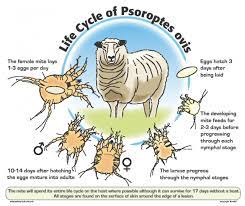SHEEP SCAB

Sheep scab is spread by any contact with live mites. This is usually through direct sheep-to-sheep contact on commons, via break-ins, at markets or in livestock
Sheep scab, or psoroptic mange, is a form of allergic dermatitis caused by infestation of the skin surface with the scab mite Psoroptes ovis. It is considered to be the most contagious endemic ectoparasite diseases affecting sheep in the UK.
The disease is characterised by a yellow scab on the skin surface, and is accompanied by restlessness, scratching, loss of wool, bleeding wounds and loss of condition.
Sheep scab has also been identified as one of the most important diseases for UK sheep farmers from both financial and welfare perspectives due to the costs associated with reduced performance, preventative measures and treatment, coupled with the apparent distress, irritation and/or pain caused.
Sheep scab used to be thought of as a disease of autumn and winter, but it is now common throughout the year. However, the majority of outbreaks still occur between September and March.
Whilst there are no official control measures in place across the UK today, there are actions that farmers can take to prevent sheep scab on their farm. Studies have shown that a single injection of Doramectin (Dectomax®) is effective for the treatment, and more importantly, prevention of infestation with Psoroptes mites. All animals in a group should be treated, regardless of whether they are showing signs of the disease or not. The mites are more active in the winter months, so a sensible time to administer prophylactic treatment is just before tupping, tying in nicely with the worming dose often given at this time. Animals should not be moved until 17 days after dosing to allow any mites in the environment to die.
Certain management strategies can help reduce the risk of disease. Double fencing between neighbouring sheep fields means that there is less chance of any lumps of wool harbouring mites making it across the borders from one group to another. Make sure that any shared handling equipment, including that belonging to visiting shearers is cleaned well between groups. Avoiding any animals at sales with suspicious signs, however mild, can help stop the mites being bought in. That said, some animals have sub-clinical disease and can harbour mites without showing any clinical signs at all. It is a good idea to watch sheep carefully after purchase and mixing and act quickly if you suspect sheep scab is a problem.
Eradication in the UK has been achieved once and other countries, such as New Zealand, have maintained their status of being sheep scab free for over a century.
